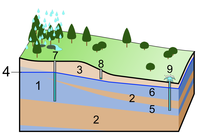
Photo from wikipedia
We used a 50-year (1961–2010) daily record of precipitation and evaporation in a hydrological model to simulate ground water withdrawal for the foodfish grow-out phase of ictalurid catfish culture in… Click to show full abstract
We used a 50-year (1961–2010) daily record of precipitation and evaporation in a hydrological model to simulate ground water withdrawal for the foodfish grow-out phase of ictalurid catfish culture in northwest Mississippi, USA. The model quantified the effects of seepage, reusing water for multiple years, and managing water levels to capture rainfall (drop-fill water management). Selecting sites with relatively impervious soils and reusing water for multiple years had large impacts on annual water use, and combining those practices with drop-fill water management reduced simulated groundwater withdrawal to less than 60 cm year−1 compared with more than 450 cm year−1 for the least conservative scenario. Water conservation measures reduced estimated costs of pumping ground water from ~$1150 ha−1 year−1 for the least conservative set of water-use variables to less than $110 ha−1 year−1 for the best set of water conservation practices. Efficiency of pumped water use was dramatically improved by intensifying production in the foodfish grow-out phase. Combining water-conservation practices with production intensification improved the water use index from 9.18 m3 kg−1 for foodfish grow-out ponds with the least conservative set of practices to 0.28 m3 kg−1 for ponds built on soils with negligible seepage, managed with a 22.9-cm drop/7.6-cm fill, drained every 10 years, and producing 15 000 kg of catfish ha−1 year−1. When simulated ground water use for the best set of water conservation practices in foodfish grow-out ponds was combined with estimates of ground water used for fingerling production and water used in producing grain-based feedstuffs, total consumptive water use index for catfish culture was estimated at ~2.7 m3 kg−1. This index is competitive with most other types of animal agriculture. Efficient water use in catfish farming is easily achieved under commercial conditions using existing simple technologies.
Journal Title: Aquaculture Research
Year Published: 2017
Link to full text (if available)
Share on Social Media: Sign Up to like & get
recommendations!